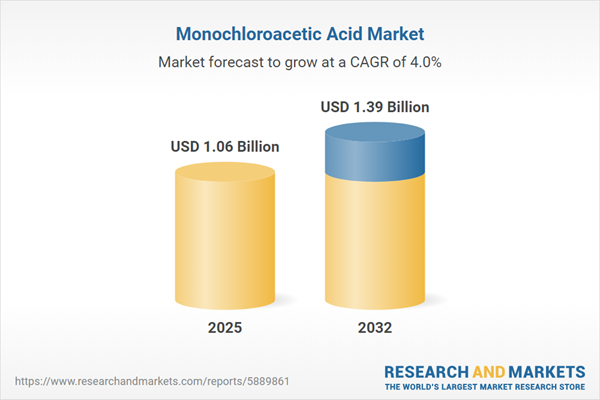Speak directly to the analyst to clarify any post sales queries you may have.
Senior leaders in the chemicals sector face a rapidly shifting marketplace shaped by regulatory pressure, technological innovation, and evolving procurement demands. In this dynamic environment, success in the monochloroacetic acid market calls for precise, actionable intelligence and a forward-thinking approach to supply chain and investment strategies.
Market Snapshot: Monochloroacetic Acid Market Growth and Outlook
The monochloroacetic acid market is currently valued at USD 1.02 billion in 2024 and is forecast to reach USD 1.06 billion by 2025, with a compound annual growth rate (CAGR) of 3.96%. Projections place the market near USD 1.39 billion by 2032. Ongoing demand in agrochemicals, pharmaceuticals, and surfactants underscores the relevance of this market. Industry stakeholders are prioritizing product quality, efficient operations, and sustainable advancements. Evolving standards and wider adoption of emerging processes are driving organizations to focus keenly on compliance and technology integration for operational efficiency.
Scope & Segmentation: Core Aspects Driving the Monochloroacetic Acid Market
This market features strategic segments that guide procurement, investment, and risk assessment for senior decision-makers. Understanding these segments supports organizations in targeting value opportunities and aligning with evolving customer and regulatory requirements.
- Applications: Includes agrochemical additives such as fungicides and herbicides, pharmaceutical intermediates for manufacturing analgesics and penicillin derivatives, and surfactant formulations used in detergents and emulsifiers. User requirements and compliance considerations within these categories influence research, development, and supplier selection priorities.
- Distribution Channels: Comprises direct sales, industry partnerships, and digital procurement platforms. Mature and digitalized channels alike enable organizations to optimize sourcing models and expand market access, suitable for diverse operational scales.
- Geographic Regions: Americas, Europe, Middle East and Africa, and Asia-Pacific. Each region introduces its own regulatory landscape, supply chain complexity, and market maturity, compelling strategic adaptation in entry, expansion, and compliance.
- Leading Companies: Principal suppliers include Dow Chemical Company, INEOS Group Holdings S.A., BASF SE, LANXESS AG, Solvay S.A., Occidental Chemical Corporation, and major Chinese producers. These organizations shape distribution networks, market structure, and innovation trajectories while influencing competitive dynamics through flexible operational models.
- Emerging Process Technologies: Adoption of digital manufacturing, green chemistry, and circular economy initiatives is accelerating. These technologies foster improved production efficiency and ensure alignment with growing regulatory and sustainability priorities across regions.
Key Takeaways for Senior Leadership
- Proactive management of regulatory changes is critical. Prioritizing investments in compliance-oriented technology safeguards against operational disruption and maintains market alignment as requirements evolve.
- Robust supplier and technology partnerships enhance supply chain reliability. Building responsive networks helps address market volatility and mitigates potential disruptions.
- Tailoring strategies to distinct markets—such as leveraging the evolving regulatory environment in North America and Europe or responding to growth momentum in Asia-Pacific—enables increased operational resilience and strategic advantage.
- Integrating both direct and digital procurement channels delivers greater transparency, accelerates lead times, and sharpens supplier selection, fostering streamlined transactions.
- Maintaining flexible logistics and diversified supply sources equips organizations to navigate sudden regulatory shifts or geopolitical changes, supporting business continuity.
Tariff Impact: Strategic Responses to US Trade Policy
Recent US tariff adjustments are prompting significant changes along the monochloroacetic acid value chain. Domestic manufacturers are focusing on sourcing local feedstock and expanding industry partnerships to manage cost and safeguard supply. International distributors, in turn, are modernizing inventory management and deepening supplier collaboration to maintain high service levels. For all market participants, closely tracking policy changes and trade dynamics remains essential to preserve operational flexibility and maintain a competitive edge in an evolving tariff environment.
Methodology & Data Sources
This market analysis combines extensive secondary research with expert consultation and stringent data validation procedures. Source materials include technical documentation, regulatory submissions, and reputable industry publications. This robust methodology ensures findings are both accurate and actionable for senior leadership seeking strategic guidance.
Why This Report Matters for Monochloroacetic Acid Market Leaders
- Delivers relevant insights on regulatory, technological, and application-driven trends shaping procurement and investment decisions in the chemicals industry.
- Supports agile adaptation to evolving risk, market demand, and sustainability imperatives, enabling the development of resilient supply chain and procurement frameworks.
- Enables leadership teams to tailor strategies in response to changing market conditions and regional trade landscapes, strengthening organizational performance and continuity.
Conclusion
This report enables chemical sector leaders to sharpen procurement, investment, and partnership strategies while reinforcing resilience and adaptability in a fast-changing market landscape.
Additional Product Information:
- Purchase of this report includes 1 year online access with quarterly updates.
- This report can be updated on request. Please contact our Customer Experience team using the Ask a Question widget on our website.
Table of Contents
3. Executive Summary
4. Market Overview
7. Cumulative Impact of Artificial Intelligence 2025
Companies Mentioned
The companies profiled in this Monochloroacetic Acid market report include:- Dow Chemical Company
- INEOS Group Holdings S.A.
- BASF SE
- LANXESS AG
- Solvay S.A.
- Occidental Chemical Corporation
- Shandong Pucheng Fine Chemical Co., Ltd.
- Jiangsu Haian Chemical Co., Ltd.
- Shanghai PCI Chemical Co., Ltd.
- Changzhou Huacheng Fine Chemical Co., Ltd.
Table Information
| Report Attribute | Details |
|---|---|
| No. of Pages | 188 |
| Published | November 2025 |
| Forecast Period | 2025 - 2032 |
| Estimated Market Value ( USD | $ 1.06 Billion |
| Forecasted Market Value ( USD | $ 1.39 Billion |
| Compound Annual Growth Rate | 3.9% |
| Regions Covered | Global |
| No. of Companies Mentioned | 11 |









